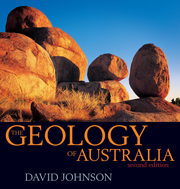Book contents
- Frontmatter
- Contents
- Map
- Preface
- Acknowledgements
- Map of main localities mentioned
- Abbreviations and units
- 1 An Australian perspective
- 2 The Earth: A geology primer
- 3 Building the core of Precambrian rocks
- 4 Warm times: Tropical corals and arid lands
- 5 Icehouse: Carboniferous and Permian glaciation
- 6 Mesozoic warming: The great inland plains and seas
- 7 Birth of modern Australia: Flowering plants, mammals and deserts
- 8 The history and evolution of life on Earth
- 9 Eastern highlands and volcanoes barely extinct
- 10 Building the continental shelf and coastlines
- 11 Great Barrier Reef
- 12 Planets, moons, meteorites and impact craters
- 13 A geological perspective on climate change
- 14 Cycles in a continental journey
- Sources and references
- Figure sources
- Index
11 - Great Barrier Reef
Published online by Cambridge University Press: 05 August 2013
- Frontmatter
- Contents
- Map
- Preface
- Acknowledgements
- Map of main localities mentioned
- Abbreviations and units
- 1 An Australian perspective
- 2 The Earth: A geology primer
- 3 Building the core of Precambrian rocks
- 4 Warm times: Tropical corals and arid lands
- 5 Icehouse: Carboniferous and Permian glaciation
- 6 Mesozoic warming: The great inland plains and seas
- 7 Birth of modern Australia: Flowering plants, mammals and deserts
- 8 The history and evolution of life on Earth
- 9 Eastern highlands and volcanoes barely extinct
- 10 Building the continental shelf and coastlines
- 11 Great Barrier Reef
- 12 Planets, moons, meteorites and impact craters
- 13 A geological perspective on climate change
- 14 Cycles in a continental journey
- Sources and references
- Figure sources
- Index
Summary
The Great Barrier Reef is one of Australia's prime assets. How old is it, and what is it built upon? Can we understand the major processes that built and maintain it?
To what extent is human activity on land affecting the reef?
INTRODUCTION TO REEFS
The coral reefs were a great hazard to the early seafarers. Even today, with highly accurate navigation equipment and powerful engines, boats, and even ships, still run onto the reefs of the Great Barrier Reef.
How much more difficult must it have been for the early explorers like James Cook and Matthew Flinders, who had to command sailing vessels that were at the vagaries of the winds and tidal currents, in navigating these waters. On 1 June 1770 Cook's vessel, HM Bark Endeavour, was firmly fixed on a reef, yet he was able to refloat it, make hasty repairs, sail to the mainland, and there careen it on a river bank at present-day Cooktown. With the repairs complete he sailed a short distance before climbing the 300-metre-high granite hill on Lizard Island to search for a way free of the reefs. From this vantage point he took a bearing on a channel to the safety of the open sea. Flinders directed steerage of the Investigator from the masthead. Both Cook and Flinders and their vessels survived their encounters with the reef.
- Type
- Chapter
- Information
- The Geology of Australia , pp. 237 - 254Publisher: Cambridge University PressPrint publication year: 2009



